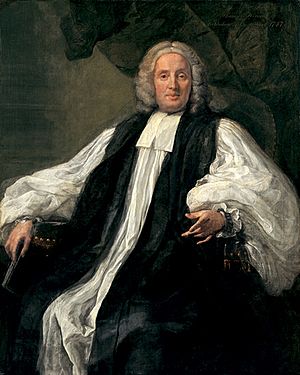Thomas Herring facts for kids
Quick facts for kids The Most Reverend and Right Honourable Thomas Herring |
|
|---|---|
| Archbishop of Canterbury | |

Portrait by William Hogarth
|
|
| Church | Church of England |
| Diocese | Canterbury |
| In Office | 1747–1757 |
| Predecessor | John Potter |
| Successor | Matthew Hutton |
| Orders | |
| Consecration | 15 January 1738 by John Potter |
| Personal details | |
| Born | 1693 Walsoken, Norfolk, England |
| Died | 23 March 1757 (aged 63-64) Croydon, London, England |
| Nationality | English |
| Denomination | Anglican |
| Parents | John Herring & Martha Potts |
| Previous post | Bishop of Bangor (1737–1743) Archbishop of York (1743–1747) |
| Education | Wisbech Grammar School |
| Alma mater | Jesus College, Cambridge |
Thomas Herring (1693 – 23 March 1757) was Archbishop of Canterbury from 1747 to 1757.
Early life and education
He was the son of John Herring, rector of Walsoken in Norfolk, who had previously been vicar of Foxton, near Cambridge, and his wife, Martha Potts.
He was educated at Wisbech Grammar School and Jesus College, Cambridge, matriculating in 1710, graduating B.A. 1714, M.A. 1717. Having migrated to Corpus Christi College, Cambridge in 1714, he was a fellow of Corpus Christi from 1716 to 1723, and graduated D.D. (comitia regia) in 1728.
At Cambridge, he was an exact contemporary of Matthew Hutton, who succeeded him in turn in each of his dioceses.
Career
Herring became a close friend of Philip Yorke, the Solicitor General, who would later, as Lord Hardwicke, serve for many years as Lord Chancellor, and as such, was able to advance quickly. In 1727 he became a chaplain to King George II, in 1732 Dean of Rochester, and in 1737 he was appointed Bishop of Bangor, consecrated 15 January 1738.
Archbishop of York
On 21 April 1743 he was translated to York and appointed Archbishop of York. On 23 September 1745, during the Jacobite rising, Herring gave a rousing sermon which, as Paul Langford notes, "captured the patriotic imagination as nothing previously had. It was to remain long in the collective mind of patriotic Protestantism."
Horace Walpole said this speech "had as much true spirit, honesty and bravery in it as ever was penned by an historian for an ancient hero". When Lord Hardwicke, the Lord Chancellor, repeated the speech's contents to King George II, the King ordered that the speech be printed in the Gazette. After Hardwicke enquired whether he should send Herring a message containing the King's admiration of "his zeal and activity", the King said this was not enough: "...you must also tell the Archbishop that I heartily thank him for it."
Herring organised Yorkshire into resistance against the Jacobites by raising volunteers and money. According to Reed Browning, Herring's behaviour during the rebellion had demonstrated that he was "a resolute Whig, a brave Briton, and a commanding prelate." Herring supported the Walpoleon Whigs because he viewed the Protestant Succession embodied in the House of Hanover as essential to Britain: "Let us remember that, next under God, Union at Home, and Loyalty and Affection to the King and his Royal Family, are our great and sure Defence." He was also deeply suspicious of France as a Roman Catholic nation and a threat to the British nation.
Archbishopric of Canterbury
On 21 Oct 1747, he was nominated as Archbishop of Canterbury. There he generally followed the lead of his friend the Lord Chancellor, and frequently came into disputes with the Duke of Newcastle, the Secretary of State. Herring, like his immediate predecessor, had taken a generally Hanoverian side through the Bangorian controversy and stood against the convocation.
Herring is generally credited as being the author of "A New Form of Common Prayer", published anonymously in 1753 in response to John Jones' "Candid Disquisitions" (1749). However, as a conciliator he eschewed controversy and rejoiced that he was "called up to this high station, at a time, when spite, and rancour, and bitterness of spirit are out of countenance; when we breathe the benign and comfortable air of liberty and toleration."
He died in 1757 and was buried in Croydon Minster in Surrey.

